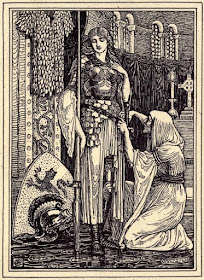Well, the day is finally here. Plane Shift: Zendikar is one of the most recent MtG settings, adapted for D&D. You can download it for free in this link.
The PDF looks stunning - as MtG art often does. The text is... well... a bit underwhelming.
You see, one of the reasons I like Ravnica is because it seems so alien to traditional fantasy. Sprawling cities, no feudalism, strange technology, one single dragon, no orcs or dwarves, and so on.
Zendikar, at least as portrayed by this PDF, seems to be the opposite. They have chaotic dragons, nice angels and evil demons, vampires scantly dressed in leather and silk, and... well, look at the Minotaurs:
Do you think such paragraph belongs in a 38 page PDF? "There are Minotaurs in Zendikar" would be enough to me, and would save some time and space (although the art is still awesome). And don't get me started on humans...
Well, the cliches seem to be intentional. It says right on the introduction that Zendikar is meant to be a "traditional D&D" world. Which makes it ideal if you want something more "generic" and easily suited, but is not the most useful setting for my tastes.
Now, there seem to be some awesome stuff in Zendikar: Lovecraftian deities, wild magic, flying island everywhere, etc. Goblins, merfolk and elves get some interesting traits (somewhat), and to be fair vampires also wear chitin carapaces in addition to leather. And the art certainly indicates there is plenty of space for creative stuff.
The problem, them, is focus: Plane Shift: Zendikar spends little time the things I consider essential for a good setting.
Factions are mentioned briefly, and other conflicts seem to be very black-and-white. The metaplot is seems to be central to the setting; I have a hard time understanding why one would be looking for gold and gems if they know Cthulhu has awakened (although I can't blame Zendikar for some of its choices, as my own Days of the Damned revolves around the awakening of Ttians, and is inspired by classic D&D settings, as well as Berserk and Dark Souls).
NPCs and locations are also not detailed; "Emeria, the Sky Ruin" and "the monstrous demon Planeswalker Ob Nixilis" sound cool, but get nothing but a mention. Hedrons, essential to the setting, are also not fully explained.
Now, I didn't intend to be so critical to a thing I waited for so long (and also not a finished product). Nor do I want to write a long review of a free product that is 38 pages long; go read it for yourself.
But for now, your best bet when immersing in MtG lore is still the internet: check the MtG wiki., where you can find about the story of Ob Nixilis, the origin of hedrons and, more importantly, what is so cool about Zendikar. You might also or one of these two sites by WotC.
Or maybe you should buy The Art of Magic: The Gathering: Zendikar... which might be the whole point.
To be honest, even the cards are more flavorful than some of the text in this product. It is hard to see how they managed to make such a vanilla PDF from this material
All in all, I'm happy WotC finally decided to give us D&D players a taste of MtGs settings. I wish they focus on some of the weirder settings, such as Ravnica and Mirrodin, or at least focus on the weirdest parts of each setting. Reading that "humans are the most numerous, diverse, and adaptable folks" is the last thing I need.
BTW, you can let WotC hear your thoughts here. I, for one, would certainly buy a "Hardback; 160-320 pages" in the vein of "The World of Ice and fire", if they do it right.
And I'd also like to hear you in the comments section!
BTW, you can let WotC hear your thoughts here. I, for one, would certainly buy a "Hardback; 160-320 pages" in the vein of "The World of Ice and fire", if they do it right.
And I'd also like to hear you in the comments section!
All art and text copyright by Wizards of the Coast LLC, used under fair use doctrine, for purposes of criticism only.











